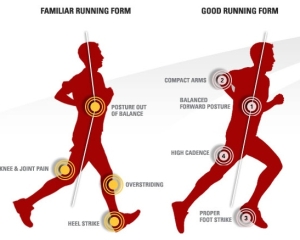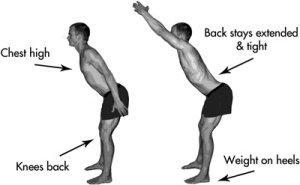Runners never want their endeavors to create a running injury. Unfortunately runners are responsible for 90% of the injuries and traumas we see in our office. The good news is, with the right training, most of these injuries can be avoided.

The Injury Cycle
Most running injuries follow a simple pattern called the injury cycle. By the time we see a runner in the office, the damage has often progressed into a state of altered neuromuscular control and/or a muscle imbalance. Like layers of an onion, we peel back the injury cycle using a variety of tools including acupuncture, Active Release Technique®, ice, chiropractic, and rehab exercises. All of these are utilized to make the runner more efficient. As proficiency increases, health and performance also increase. Running should be an elastic activity, where we use ourselves as biological springs. A good runner is able to do this effectively. The vast majority of runners have never experienced the true joy of running because repetitive grind of overcoming gravity is all consuming.
There are many aspects to efficient, effective, and enjoyable running. Perhaps the most fundamental is posture. Surprisingly it is not just the slumped, slouch-shouldered runner with a posture problem. It is also the runner assuming the so called “athletic posture” which is usually tense, straining upward, with shoulders pinned back.
 Runners in all disciplines are often exhorted to “stay high,” but instead of generating this from the lower body, they create the impulse in their spine. From the side-view, they actually appear to have their shoulders behind their hips as they try to stay up. This is running with the hand brake on. The stiff spine blocks the natural rotation which stores and releases elastic energy while diminishing effectiveness. It also makes the individual’s muscles work harder as they start to push more to make up for the loss in energy. This is not good news for a distance runner. Having the shoulders wedged back makes it difficult for the muscles at the back of the hips to activate effectively. In turn, hip flexors must work harder, causing sprinters to complain of tightness in hip flexors and strained hamstrings.
Runners in all disciplines are often exhorted to “stay high,” but instead of generating this from the lower body, they create the impulse in their spine. From the side-view, they actually appear to have their shoulders behind their hips as they try to stay up. This is running with the hand brake on. The stiff spine blocks the natural rotation which stores and releases elastic energy while diminishing effectiveness. It also makes the individual’s muscles work harder as they start to push more to make up for the loss in energy. This is not good news for a distance runner. Having the shoulders wedged back makes it difficult for the muscles at the back of the hips to activate effectively. In turn, hip flexors must work harder, causing sprinters to complain of tightness in hip flexors and strained hamstrings.
Performance Tip
Runners, RELAX! Carry yourself lightly rather than holding yourself up. All that extra tension is holding you back. Proper running form is not simply learned by running differently. It has to be mastered in sections and put together on the road. Here are two core exercises that can help train better running posture.

The Founder:
Stand with feet wider than shoulder width apart. Keep your weight on your heels. Bend forward at the waist while keeping your chest high. Keep the back slightly extended and your knees behind your toes. With your hands at your sides, rotate internally the hands all the way and pinch your shoulder blades together. Hold for 30 seconds. Next, only move your arms into an extended overhead position. Spread your fingers wide and push your hands to the ceiling. Hold again for 30 seconds. Repeat 2X. 
Monster Walk:
With a 12” looped resistance band around each leg just below the knee (or around the arch of each foot), drop into athletic position: hips are back, knees behind the toes, back slightly extended, and chin up. Slide across the room 10-15 paces in a side lunge movement pattern. Repeat across the floor in alternating directions for 30 seconds to one minute.
Visit CoreRoanoke.com/resources/running for more running resources, including a video tutorial on how to prime your body for running. Questions? Give us a call at 540.344.1055 or email us at DrRich@CoreRoanoke.com.
Dr. Daryl Rich, DC, CSCS, ART®






